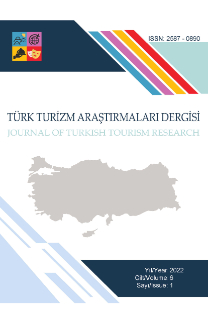Konfor Gıda Tüketimi: Mersin’den Örnekler
Consumption of Comfort Foods: Examples from Mersin
___
- Babicz-Zielińska, E. (2006). Role of Psychological Factors in Food Choice-A Review, Polish Journal of Food and Nutrition Sciences, 15(56), 379-384.
- Çağlar, T. A. (2016). Mersin ve Tarsus Halk Kültürü. Nisan: Mersin Büyükşehir Belediyesi Kültür Yayınları.
- Dubé, L., LeBel, J. L. and Lu, J. (2005). Affect Asymmetry and Comfort Food Consumption, Physiology & Behavior (86), 559-567.
- English Oxford Living Dictionaries (2017). "Comfort Food" Definition, [URL: https://en.oxforddictionaries.com/definition/comfort_food], Erişim Tarihi: 10.08, 2017.
- Fearnley-Whittingstall, H. (2012). The Guardian, What Does Comfort Food Mean to You?, [URL: https://www.theguardian.com/lifeandstyle/wordofmouth/2012/jan/18/what-does-comfort-foodmean-to-you], Erişim Tarihi: 07.09.2017.
- Kandiah, J., Yake, M., Jones, J. and Meyer, M. (2006). Stress Influences Appetite and Comfort Food Preferences in College Women, Nutrition Research, 26, 118-123.
- Kim, Y., Yang, H.-Y., Kim, A.-J. and Lim, Y. (2013). Academic Stress Levels were Positively Associated with Sweet Food Consumption Among Korean High-School Students, Nutrition, 29, 213-218.
- Locher, J. L., Yoels, W. C., Maurer, D. and Ells, J. (2005). Comfort Foods: An Exploratory Journey into the Social and Emotional Significance of Food, Food & Foodways, 13(4), 273-297.
- Long, L. M. (2017). Comfort Food in Culinary Tourism: Negotiating "Home" as Exotic and Familiar. (Editor) M. O. Jones and L. M. Long, Comfort Food Meanings and Memories (pp. 126-149). United States of America: University Press of Mississippi.
- Mason, M. (2010). Sample Size and Saturation in Phd Studies Using Qualitative Interviews, Forum: Qualitative Social Research, 11(3), 1-19.
- Mersin İl Kültür ve Turizm Müdürlüğü, Ne Yenir?, [URL: http://www.mersinkulturturizm.gov.tr/TR-73474/ne-yenir.html], Erişim Tarihi: 12.12.2018.
- Shepherd, R. and Dennison, C. M. (1996). Influences on Adolescent Food Choice, Proceedings of the Nutrition Society, 55, 345-357.
- Spence, C. (2017). Comfort Food: A Review, International Journal of Gastronomy and Food Science, 9, 105-109.
- Tryon, M. S., DeCant, R. and Laugero, K. D. (2013). Having Your Cake and Eating It too: A Habit of Comfort Food May Link Chronic Social Stress Exposure and Acute Stress-Induced Cortisol Hyporesponsiveness, Physiology & Behavior, 114-115, 32-37.
- Türkan, C. (2012). Aşçılık-Ev Hanımları için Kaşık ve Bardak Ölçüleriyle (6 b.). Bolu: Sistem Ofset.
- Vabø, M. and Hansen, H. (2014). The Relationship Between Food Preferences and Food Choice: A Theoretical Discussion, International Journal of Business and Social Science, 5(7), 145-157.
- Wansink, B. and Sangerman, C. (2000). Engineering Comfort Foods, American Demograpies (66- 67), 1-7.
- Yazıcıoğlu, İ., Işın, A. ve Koç, B. (2013). Üniversite Öğrencilerinin Fast Food Ürünleri Tercih Etme Nedenleri, Journal of Tourism and Gastronomy Studies, 1(1), 36-41.
- ISSN: 2587-0890
- Yayın Aralığı: 4
- Başlangıç: 2017
- Yayıncı: Prof. Dr. Yüksel ÖZTÜRK
Restoran Müşterilerinin Personel İletişim Düzeyi Algıları ve Memnuniyetleri Arasındaki İlişki
OZAN BÜYÜKYILMAZ, ÖMER CEYHUN APAK
Turizm Endüstrisinde Blogların Gücü ve Turist Rehberleri Açısından Bir Değerlendirme
Mithat Zeki DİNÇER, TOLGA FAHRİ ÇAKMAK, MERVE AYDOĞAN ÇİFÇİ
Türk Dünyası’nın Tanıtımında “Modern İpek Yolu Ortak Tur Paketi”
Elif Esma KARAMAN, NESLİHAN ÇETİNKAYA
SALİH KUŞLUVAN, Olcay YÜCEL, Karel Van ISACKER, António Silva DIAS, Petia GRUDEVA, Filip NICASI, Zdenka WLTAVSKY
Konfor Gıda Tüketimi: Mersin’den Örnekler
Serpil YALIM KAYA, Neslihan ŞİMŞEK, Celil ÇAKICI
SERCAN YILDIZ, LEVENT SELMAN GÖKTAŞ, Tuncay HABİL, F. Füsun İSTANBULLU DİNÇER
Türk Devletlerinin Turizm Rekabetçilik Performansının Homojenlik Analizi
